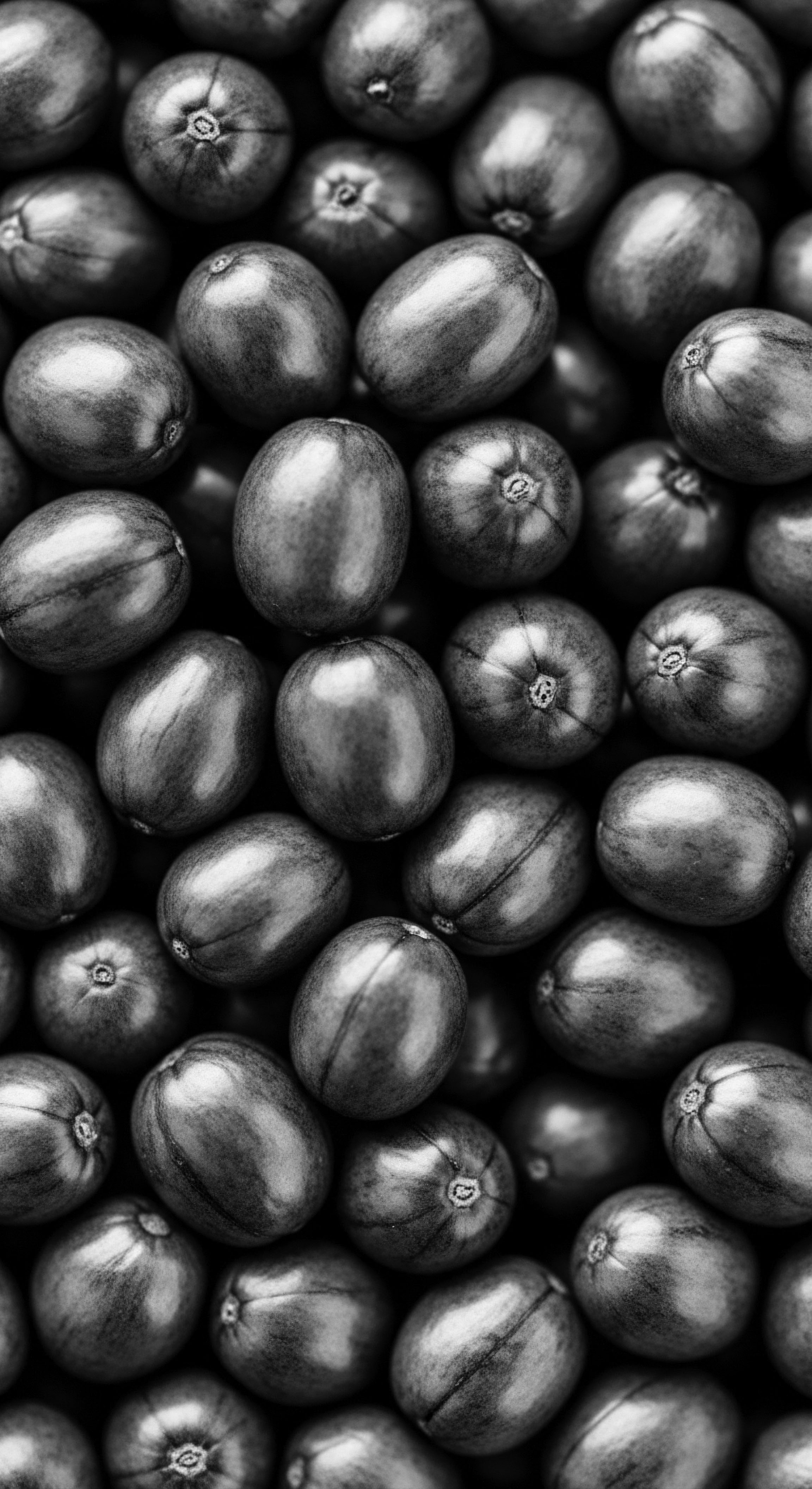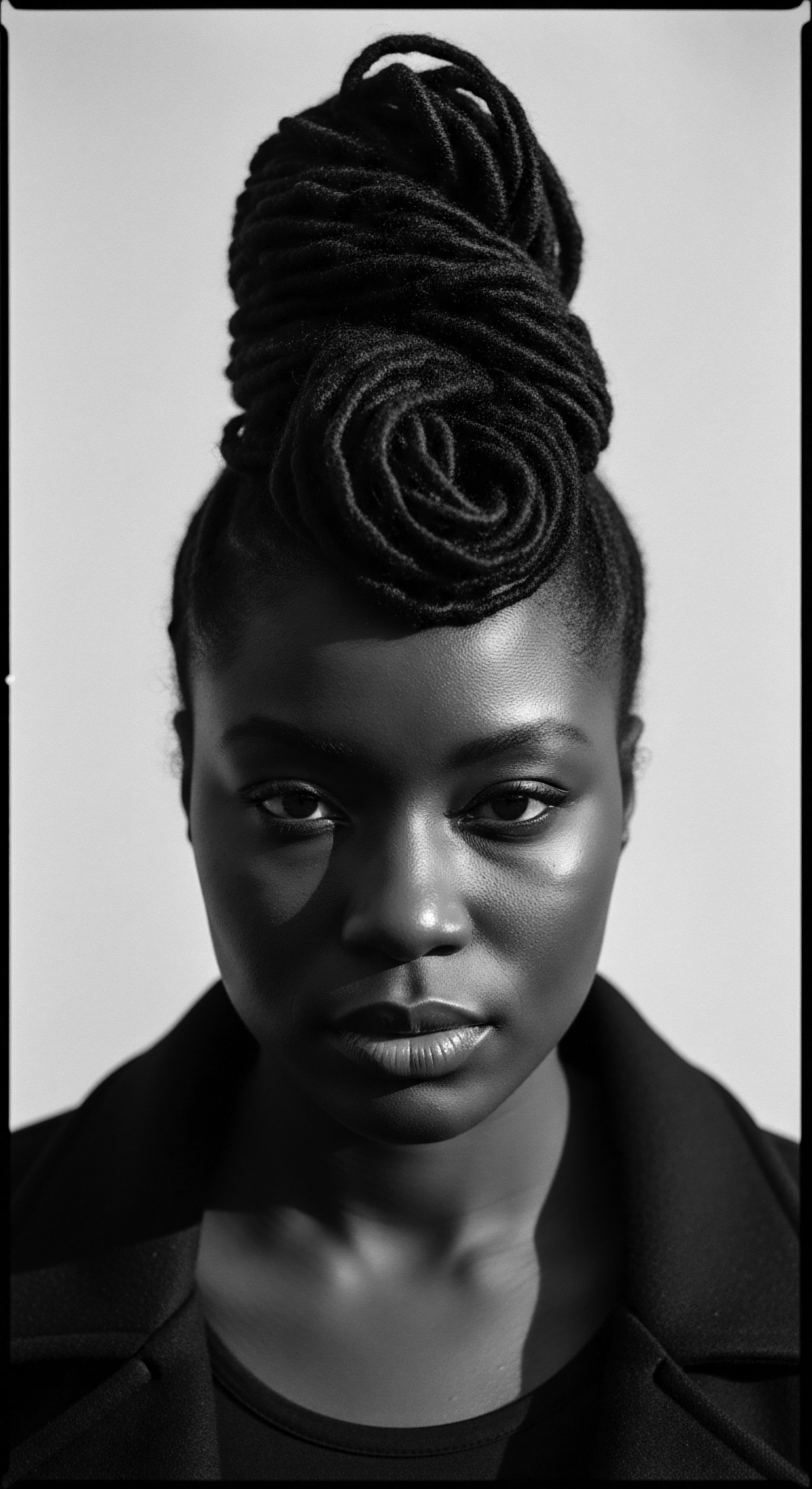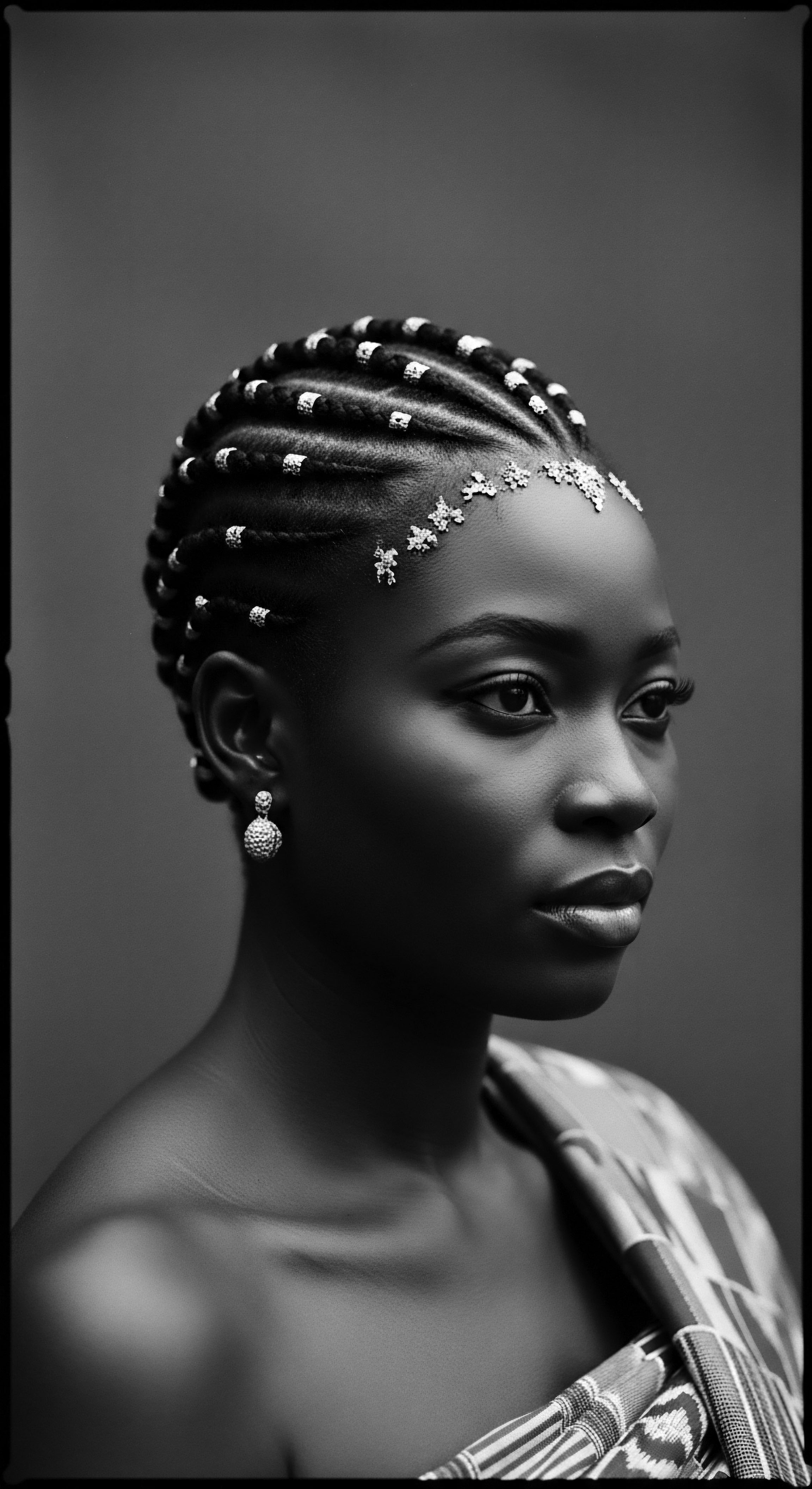
Roots
Consider for a moment the very strands that spring from your scalp—each curl, each coil, a tiny vessel carrying whispers of generations. These aren’t mere fibers; they are living archives, imbued with the fortitude of journeys, the quiet wisdom of sun-drenched lands, and the gentle resilience passed down through hands that have cared for textured hair since the dawn of time. To understand the profound influence of ancestral practices on how we tend our textured hair today, and indeed, the nightly coverings that shield it, one must first listen to the echoes from the source—the elemental biology that connects us to those who came before. It is a story etched not just in history books, but in the very helical structure of the hair itself, a narrative of heritage braided into every act of care.

Hair’s Elemental Blueprint
The architectural marvel that is textured hair begins at a cellular level, a complex interplay of genetic coding and environmental adaptation. Unlike straight hair, the elliptical cross-section of a textured strand, combined with a unique pattern of disulfide bonds and a slower rate of keratinization along the inner curve of the follicle, lends it its signature curl. This inherent curvature, while visually splendid, means the hair shaft is naturally predisposed to dryness and breakage.
The cuticle layers, those delicate scales that protect the inner cortex, don’t lie as flat, leaving the hair more exposed and prone to moisture loss. This fundamental biological reality shaped ancestral responses to hair care, fostering a deep respect for hydration and protection, a wisdom that reverberates in contemporary practices.
The genetic blueprint of textured hair, with its inherent curvature and delicate cuticle, necessitated ancient practices centered on deep hydration and protective care.

Naming the Coils
Our modern attempts to classify textured hair, often through numerical and alphabetical systems (e.g. 3C, 4A), represent a contemporary quest for understanding. Yet, long before such scientific nomenclature, ancestral communities held their own ways of knowing and naming. These distinctions were not always formal categories, but rather an intuitive understanding of hair’s spirit and behavior, tied to its appearance, its response to moisture, and its cultural significance.
The terms used were often descriptive, reflecting the hair’s resemblance to natural elements or its role in identity. The heritage of these intuitive classifications reminds us that understanding hair goes beyond scientific charts; it reaches into a felt, lived knowledge.

The Living Cycle of Growth
Hair, regardless of its texture, undergoes a cyclical journey of growth, rest, and shedding. The anagen phase, where hair actively grows, is typically shorter for textured hair compared to other hair types, which contributes to its perceived slower growth rate. The catagen and telogen phases, periods of transition and rest, follow. Ancestral peoples, through generations of keen observation, understood these cycles intimately.
Their practices, whether through gentle handling, the application of nourishing balms, or the meticulous creation of protective styles, aimed to prolong the anagen phase and minimize breakage during the vulnerable transitional stages. This observational heritage informed regimens long before microscopes revealed cellular truths.

Environmental Wisdom and Hair Well-Being
For ancestral communities across various African regions, the immediate environment dictated many hair care responses. The arid climates of the Sahel, the humid conditions of the rainforests, or the coastal breezes of West Africa—each presented unique challenges and offered diverse botanical solutions. For instance, communities in regions with significant sun exposure learned the importance of thick, emollient applications to shield hair from drying rays, and the necessity of coverings to prevent moisture evaporation.
The practice of oiling the scalp and strands with locally sourced butters and oils was not merely a cosmetic act; it was a climatic adaptation, a survival strategy for hair health. This localized, environmentally attuned heritage underpins much of what we seek in modern hair care.
- Shea Butter ❉ From the karite tree, used across West Africa for its deep moisturizing and protective properties, often applied to the scalp and hair to seal in moisture and offer sun protection.
- Castor Oil ❉ A West African and Caribbean staple, historically valued for its perceived ability to strengthen hair and promote growth, particularly for thicker textures.
- Aloe Vera ❉ Used in various African cultures for its soothing and hydrating qualities, often applied as a conditioner or scalp treatment.
The very biology of textured hair, with its unique structural needs, laid the groundwork for care practices that have traveled through time. From understanding its delicate curl pattern to recognizing its growth cycles, ancestral wisdom provided the first, most fundamental answers to keeping this hair vibrant. These foundational insights, born of deep observation and practical necessity, form the bedrock of our present-day understanding, a continuous thread of heritage connecting us to those original tenders of the strand.

Ritual
The care of textured hair, far from being a mundane chore, has always existed as a profound ritual, a language spoken through fingers, combs, and the earth’s own offerings. This ritualistic approach, passed across generations, is where ancestral practices truly show their persistent influence on our styling techniques, tools, and the very transformations we seek for our hair today. These practices were not just about aesthetics; they were acts of communal connection, expressions of status, and declarations of identity.

The Art of Protective Styling
Perhaps no aspect of textured hair care demonstrates ancestral wisdom more clearly than protective styling. Before the advent of modern product lines, braids, twists, and locs served as the ultimate shield against environmental aggressors. These styles, often intricate and time-consuming, were born of necessity and elevated to artistry. West African communities, for instance, employed myriad braiding patterns that signified marital status, age, tribal affiliation, or even one’s role within the community.
The act of creating these styles was a communal affair, often performed by elders, fostering intergenerational bonding and transmitting cultural heritage . The tightly wound strands, gathered and secured, minimized manipulation, retained moisture, and promoted length retention, principles that remain cornerstones of protective styling today.

From Coils to Crowns?
The definition of natural hair, the very showcasing of one’s inherent texture, also has ancient roots. While protective styles were vital, moments of unadorned hair, or hair styled to emphasize its natural volume and curl, were also significant. In many African societies, the hair, when not braided or covered, was often adorned with shells, beads, or precious metals, transforming it into a living crown. These adornments were not mere decorations; they held symbolic power, reflecting spiritual beliefs, achievements, or social standing.
The application of natural oils and butters during these styling sessions was a ritual of hydration and enhancement, ensuring the hair remained supple and strong even when styled openly. This direct connection to the earth’s bounty, a practice of deep care for what naturally grows, remains a powerful part of our heritage in natural styling.
| Ancestral Tool/Practice Bone Combs |
| Function and Cultural Context Carved from animal bone, used for detangling and styling. Often imbued with spiritual significance or artistic expression. |
| Modern Parallel/Influence on Care Today Wide-tooth combs and detangling brushes, prioritizing minimal tension and gentle detangling, reflecting the need for delicate handling. |
| Ancestral Tool/Practice Gourd Bowls & Pestles |
| Function and Cultural Context Used for mixing and crushing natural ingredients like herbs, clays, and butters for hair treatments. |
| Modern Parallel/Influence on Care Today Mixing bowls and spatulas for DIY hair masks, or the careful formulation processes behind contemporary natural product lines. |
| Ancestral Tool/Practice Ash & Clay Treatments |
| Function and Cultural Context Applied to cleanse the scalp, absorb excess oil, and provide minerals, sometimes used for dreadlocking processes. |
| Modern Parallel/Influence on Care Today Bentonite clay masks and detoxifying scalp treatments, drawing from earth-based cleansing principles. |
| Ancestral Tool/Practice These ancient methods, though simplified by technology, speak to an enduring understanding of textured hair's needs and a deep connection to its heritage . |

The Historical Reach of Wigs and Extensions
The practice of augmenting hair with extensions or wigs is far from a modern invention. Ancient Egyptians, for example, were renowned for their elaborate wigs, crafted from human hair, plant fibers, or even wool, and often infused with fragrant oils and resins. These were worn for protection against the harsh sun, for hygiene, and as powerful symbols of wealth, status, and beauty.
Similarly, in various African societies, hair extensions, crafted from natural fibers or donated hair, were seamlessly braided into existing strands to create more voluminous or longer styles for ceremonial purposes or social distinctions. This heritage of hair augmentation points to a timeless human desire for creative expression and adaptability, using external elements to shape and reshape one’s aesthetic identity.

Heat and Hair ❉ A Delicate Balance Across Eras
While modern heat styling tools offer instant transformation, their historical counterparts were used with caution. In some African traditions, natural substances like hot stones or plant sap were occasionally employed for rudimentary straightening or to aid in the application of certain treatments, but such methods were often limited and understood to carry risks. The emphasis remained on natural states and protective measures.
This historical context highlights the delicate balance between altering hair’s natural state and preserving its integrity. It reminds us that our contemporary conversation around heat safety, often driven by scientific understanding, echoes an older, intuitive caution about over-manipulation, a whisper from our hair’s deep heritage .
The meticulous care and transformative artistry woven into ancient hair rituals continue to resonate in our present-day practices. From the communal act of braiding to the strategic use of natural elements and tools, each step in our hair care routines carries the imprint of ancestral wisdom. These rituals, once essential for survival and identity, now serve as powerful connections to a rich and vibrant heritage , reminding us that beauty is often found in the preservation of tradition.

Relay
The legacy of ancestral practices is not a static relic; it is a dynamic relay, a continuous transfer of wisdom that informs our current understanding of holistic textured hair care, nightly rituals, and problem-solving. This deep transmission, often unspoken and felt, allows us to connect contemporary scientific inquiry with the profound intuitive knowledge of our forebears, particularly when it comes to the unique needs of textured hair. The conversation between past and present yields a richer, more comprehensive approach, validating ancient insights through modern lenses and deepening our appreciation for our hair’s living heritage .

Formulating Personal Care Regimens
The concept of a “regimen”—a structured approach to hair care—finds its genesis in ancient practices where consistency and intentionality were paramount. Ancestral communities understood that textured hair thrived on a balance of cleansing, moisturizing, and protection. Their regimens, while not codified with modern terms like “pre-poo” or “co-wash,” involved pre-treatment with oils or butters to loosen debris and provide slip, followed by gentle cleansing with natural soaps or clays, and then the application of emollients to seal in hydration. The frequency of these rituals was often tied to climate, lifestyle, and social events.
Modern regimens, advocating for moisture retention, minimal manipulation, and gentle cleansing, reflect a timeless understanding of hair’s fundamental requirements. This continuity in approach demonstrates the enduring power of observational heritage in designing effective care routines.

What Nightly Rituals Protect Textured Hair’s Ancestral Lineage?
Perhaps one of the most visible and widely adopted ancestral practices in current textured hair care concerns nightly coverings. The use of headwraps, scarves, and later, bonnets, is not merely a modern trend; it is a direct continuation of an age-old tradition rooted in both practicality and cultural significance. Historically, in many African societies, head coverings served multiple purposes ❉ protection from the elements, a symbol of modesty, a sign of status or spiritual devotion, and critically, a means of preserving intricate hairstyles for days or even weeks. These coverings shielded delicate styles from friction, dust, and moisture loss during sleep, extending the life of protective braids and twists.
The shift to softer materials like silk and satin in modern bonnets and pillowcases echoes the ancestral goal of reducing friction, thereby minimizing breakage and maintaining moisture. This uninterrupted lineage of nighttime protection is a powerful testament to our living heritage .
Nightly hair coverings, a practice with deep ancestral roots, continue to protect textured hair from friction and moisture loss, preserving style and health.

Ingredients as Inherited Wisdom
The deep reverence for natural ingredients in textured hair care is a direct inheritance. Long before laboratories synthesized complex chemicals, ancestral communities relied on the earth’s bounty—plants, seeds, and minerals—for their hair’s nourishment. These ingredients, selected through generations of trial and observation, offered remedies for dryness, breakage, and scalp conditions.
- Baobab Oil ❉ Extracted from the seeds of the majestic baobab tree, this oil, used for centuries in parts of Africa, is rich in omega fatty acids, known to provide deep moisture and improve hair elasticity.
- Chebe Powder ❉ A traditional Chadian mixture of natural herbs, applied to hair for length retention and strength, rooted in indigenous hair care practices for centuries.
- Rhassoul Clay ❉ Originating from the Atlas Mountains of Morocco, this mineral-rich clay was historically used as a natural cleanser and conditioner, absorbing impurities while conditioning the hair.
Modern scientific analysis often corroborates the efficacy of these ancient remedies. For example, the well-documented use of shea butter for its emollients and anti-inflammatory properties, or the rich vitamin profile of various plant oils, aligns with their traditional applications. A study published in the Journal of Ethnopharmacology examined the use of Butyrospermum parkii (Shea Butter) in traditional African medicine, noting its long-standing application for skin and hair health due to its high concentration of fatty acids and unsaponifiable compounds, which contribute to its occlusive and emollient qualities (Akihisa et al.
2010). This empirical validation of traditional knowledge strengthens the bond between ancestral wisdom and contemporary science, affirming the intelligence embedded in our heritage practices.

Solving Hair’s Challenges
Challenges like excessive shedding, dryness, or scalp irritation are not new. Ancestral methods for problem-solving often involved topical applications of herbs, dietary adjustments, and specific grooming techniques. For instance, addressing hair thinning might have involved scalp massages with stimulating oils or the consumption of nutrient-rich foods known to support hair growth.
The modern focus on scalp health, internal nutrition, and tailored product formulations for specific issues mirrors these older approaches. The wisdom of tending to the whole person, not just the hair strand, is a deeply ingrained aspect of our heritage when it comes to hair wellness.

A Holistic View of Hair Well-Being
Beyond physical care, ancestral practices underscored the holistic connection between hair and overall well-being. Hair was often considered a conduit for spiritual energy, a crown of self-expression, and a vital link to one’s lineage. Care rituals were therefore imbued with intention, often accompanied by song, storytelling, or prayer. This holistic view meant that stress, diet, and spiritual harmony were all seen as impacting hair health.
Contemporary wellness movements that link hair health to mindfulness, stress reduction, and nutrient-dense diets are, in essence, rediscovering this foundational ancestral truth. The legacy of treating hair as an integral part of the self, deserving of reverence and mindful attention, is a beautiful and enduring aspect of our hair heritage .
The continuous relay of ancestral wisdom, spanning from daily regimens to profound philosophical understandings, enriches our present-day textured hair care. It offers not just practices, but a lens through which to view our hair as a sacred extension of self and lineage, connecting us inextricably to the vibrant narrative of our heritage .

Reflection
The journey through ancestral practices influencing current textured hair care and nightly coverings reveals a continuum of profound wisdom. Each practice, whether it be the meticulous creation of a protective braid, the thoughtful anointing with a natural butter, or the simple act of wrapping the hair before rest, is more than a technique; it is a living echo. It is a testament to the ingenuity and deep observational intelligence of those who walked before us, whose hands instinctively understood the needs of textured hair long before scientific terms articulated its specific biology. Our present-day routines, the very tools we use, and the care philosophies we adopt are steeped in these ancient legacies.
The strands that grow from our heads are not merely protein filaments. They are conductors of stories, carriers of resilience, and silent witnesses to generations of innovation, adaptation, and profound beauty. To engage with textured hair care, particularly through the lens of its ancestral roots, is to partake in a rich, ongoing conversation—a dialogue between ancient wisdom and modern understanding. It is to honor the hands that braided, the communities that shared, and the spirits that found expression through hair.
Our modern bonnets and silk scarves are not just accessories; they are modern vessels carrying the ancient intent of protection and preservation. This deep, unbroken chain of heritage reminds us that the soul of a strand is, indeed, a living, breathing archive, continuously unfolding its luminous narrative.

References
- Akihisa, T. et al. (2010). Triterpene alcohol and fatty acid composition of shea butter from some African countries. Journal of Ethnopharmacology, 130(2), 221-228.
- Byrd, A. D. & Tharps, L. D. (2014). Hair Story ❉ Untangling the Roots of Black Hair in America. St. Martin’s Griffin.
- Gordon, A. (2007). African Textiles and Decorative Arts. The Museum of Modern Art.
- Okoro, N. (2018). African Traditional Hair Care ❉ A Comprehensive Guide. Heritage Publishers.
- Opoku, R. A. (2009). The African Hair ❉ An Ethnographic Study. University of Ghana Press.
- Tharps, L. D. (2001). Hair Story ❉ Untangling the Roots of Black Hair in America. St. Martin’s Press.
- White, S. (2019). The History of African American Hair ❉ A Cultural Exploration. University of Chicago Press.
